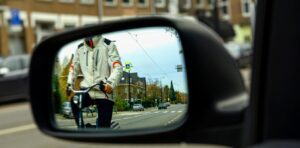Walking in African cities can be a miserable experience: Accra study shows planners ignore needs of pedestrians

African cities aren’t welcoming places for pedestrians. Yet walking is free and, given the shortage of decent public transport, it’s often the only way for people to move around. More than 70% of Africa’s urban population of about 609 million walk daily to their various destinations.
As researchers who study urban development, we are always looking for insights that planners and city authorities can use to make African and global south cities socially equitable, sustainable and resilient.
In a recent paper we reviewed some of Ghana’s urban planning and transport policies, exploring the extent to which policy makers and city authorities planned for and implemented interventions that addressed the needs of walkers. We then contrasted what we found with the walking experiences of residents of two low-income settlements in Accra.
Over three-quarters (75.3%) of the national population make up to ten daily trips to places such as schools, market places and churches on foot. A similar trend was found in our study, where more than two thirds make daily trips on foot.
While Ghana has several transport and local development planning policies, our findings suggest serious gaps between policies and reality. They provide insights into why cities in Africa face persistent difficulties in connecting development initiatives to the pressing needs of the urban poor.
Our results show that policies and municipal plans give little attention to how walking can be made a pleasant experience. We also found that policies and plans didn’t match residents’ actual experiences of walking.
We recommend that city planners work with residents to come up with solutions for making urban neighbourhoods walkable. An example of this comes from Freetown in Sierra Leone, where development planners, academics and residents came together to produce a walking database to inform the planning of changes to the city.
Walkability in Africa’s urban transport policies
Some African cities have included strategies for walking in their transport policies.
For instance, in Lagos (Nigeria), the Lagos Metropolitan Area Transport Authority developed a policy to increase walking by creating a safe and pleasant network of footpaths, greenways and other facilities. In Addis Ababa (Ethiopia), a similar policy was developed. Its aim was to encourage people to walk and to improve connectivity to public transport.
Nairobi (Kenya) has a similar policy to improve the walking environment. It has classified all roads and streets in the city to assess the desirability for walking. The policy also prioritises pedestrians over private cars and trucks in some areas, for example by restricting car use.
All these policies are commendable. But putting them into practice has been hampered by challenges such as funding, public perception and technical capacity.
Against this backdrop, the Accra study analysed how the provisions in national transport policies and local development plans aligned with residents’ lived experiences to co-produce knowledge to prevent such challenges.
Accra’s pedestrians
We chose two study sites, Accra New Town and Dome, located in Ayawaso North Municipality and the Ga East Municipality, to represent inner-city and suburban areas.
We used in-depth and semi-structured interviews to capture the perspectives of representatives who worked for the local government as well as residents of the study communities. Our questions were designed to understand the accessibility and safety of pedestrian walkways and what the experience was like.
Accessibility: Current policies are designed to provide dedicated, safe, reliable and appropriate facilities for pedestrians. But our research showed that there was no pedestrian-friendly infrastructure to ensure access to facilities and services. Planners alluded to lack of funds and competing development challenges. Residents described walking as precarious, as they had to compete for walking space with vendors and motorists. An interview with one of the participants from Accra New Town revealed:
The current roads that we have in the neighbourhood are in poor condition, and many of them lack sidewalks and footbridges to allow people to cross the streets.
Safety: The research showed a chasm between policy ambitions for walking and realities at the community level. Municipal development plans didn’t set out actionable strategies to address the road-user conflict. We were told of frequent crashes involving commuters, vendors and motorists. Reflecting on the safety situation in Dome, one of the participants said:
When you are walking with your phone, if you are not smart, they can take your phone anytime. So, it’s very scary … it will be good if the local government focuses on that area because children also walk there.
Pedestrians are the most at risk. Data shows that they suffer 39.5% of transport-related fatalities in Ghana.
Pleasurability: This was the least considered in both national-level policy and municipal development plans. There was no sign of facilities and infrastructure offering comfort or aesthetics to improve the walking experience of pedestrians. These include street trees, benches and garbage bins.
In both study sites there was uncollected garbage on the roads and offensive smells. A resident of Accra New Town said:
We have periodic cleanup exercises, led by the assembly member, to clear up the streets and big gutters to allow free flow of the water and also reduce the odour and the dusty roads.
Making cities walkable
The deep gulf between what the policies say and everyday experiences in our study calls for new ways of thinking and doing within the urban transport and development planning regime.
We suggest that city planners and policymakers should consider designing ways to make walking easier in collaboration with citizens.
Giving communities a chance to participate and share what they know can turn African urban residents from captive walkers to walkers who enjoy their city.
Maria José Nieto-Combariza, PhD scholar at the Bartlett Development Planning Unit, University College London, contributed to this article.






